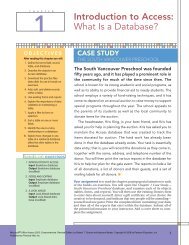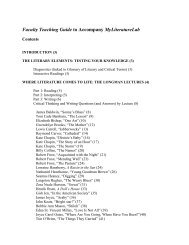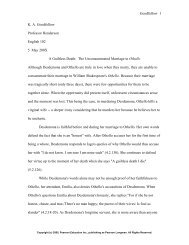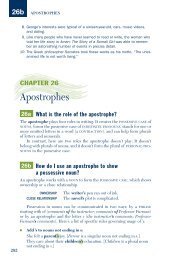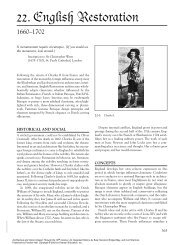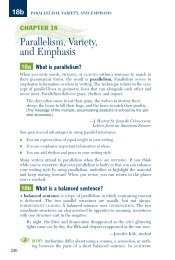chapter 3 - Pearson Learning Solutions
chapter 3 - Pearson Learning Solutions
chapter 3 - Pearson Learning Solutions
You also want an ePaper? Increase the reach of your titles
YUMPU automatically turns print PDFs into web optimized ePapers that Google loves.
2009934667<br />
group’s operation. If, for example, people are seated in a tight circle, they will<br />
probably feel more comfortable and interact more than they would if they were<br />
sitting in straight rows. They will be able to see each other’s nonverbal reactions,<br />
and because there is no inhibiting physical distance, they will lose their selfconsciousness<br />
as they become members of the group.<br />
Business organizations make considerable use of such nonverbal strategies in<br />
small-scale conferences. One technique is to seat key members of the group in<br />
prominent positions to stimulate discussion or even direct it.<br />
Paravocalics: Vocal Communication<br />
Chapter 3 Nonverbal Communication 77<br />
The vocal effects that accompany words, such as tone of voice—but not the words<br />
themselves—are called paravocalics. 85 Vocal quality communicates nonverbally to<br />
the listening ear. The rate (speed), volume (power), pitch (such as soprano or bass),<br />
pause (stopping), and stress (intensity) of sounds all have particular meanings.<br />
These paravocal tools are often referred to as vocal cues.<br />
Vocal cues offer clues to determine the sex, age, and status of a speaker. We<br />
also can make some pretty accurate judgments about the emotions and feelings of<br />
the people with whom we communicate by their paralinguistic presentation. If you<br />
are very angry, the pitch of your voice may go up. And when you are very, very<br />
angry, you sometimes say words slowly and distinctly, pausing after each word for<br />
special effect.<br />
Research indicates that the voice also may be important in some aspects of persuasion.<br />
86 A faster rate of speech, more intonation, greater volume, and a less halting<br />
manner seem to be related to successful attempts at persuasion. If a person sounds<br />
assured, the receiver credits him or her with a higher degree of credibility. Network<br />
television anchors, for example, work to cultivate an assured broadcast voice.<br />
Vocal cues can provide much information about a speaker, and our overall<br />
reaction to another person is colored at least somewhat by our reactions to these<br />
cues. Perceptions of vocal cues, combined with other verbal and nonverbal stimuli,<br />
mold the conceptions we use as bases for communicating. 87<br />
Formal time is the way in<br />
which a culture defines its<br />
time and the role it plays in<br />
regulating our lives.<br />
Communicating: A Social and Career Focus, Tenth Edition, by Roy M. Berko, Andrew D. Wolvin, and Darlyn R. Wolvin. Published by Allyn & Bacon.<br />
Copyright © 2007 by <strong>Pearson</strong> Education, Inc.






